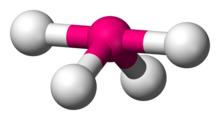Seesaw (chemistry)
| Seesaw molecular geometry | |
|---|---|
 |
|
| Examples | SF4 |
| Point group | C2v |
| Steric number | 5 |
| Coordination number | 4 |
| Bond angle(s) | 90°, 120°, 180° |
| μ (Polarity) | >0 |
Disphenoidal or Seesaw is a type of molecular geometry where there are four bonds to a central atom with overall C2vsymmetry. The name "seesaw" comes from the observation that it looks like a playground seesaw. Most commonly, four bonds to a central atom result in tetrahedral or, less commonly, square planar geometry. The seesaw geometry, just like its name, is unusual.
It occurs when a molecule has a steric number of 5, with the central atom being bonded to 4 other atoms and 1 lone pair. (AX4E in AXE notation) An atom bonded to 5 other atoms (and no lone pairs) forms a trigonal bipyramid; but in this case one of the atoms is replaced by a lone pair. The atom replaced is always an equatorial atom, because the lone pairs repel other electrons more strongly than atoms do.
Compounds with disphenoidal geometry (See-Saw Geometry) have two types of ligands, one pair related by 180° often called axial ligands. A separate pair of ligands is situated orthogonal to the axial ligands. Typically the bond distance to the apical ligands is longer than to the equatorial ligands. The angle between the axial ligands and the equatorial ligands is 90°; whereas the angle between the two equatorial ligands themselves is 120°.
Disphenoidal molecules, like trigonal bipyramidal ones, are subject to Berry pseudorotation. Thus, the 19F NMR spectrum of SF4 (like that of PF5) consists of single resonance near room temperature. The four atoms in motion act as a lever about the central atom; for example, the four fluorine atoms of sulfur tetrafluoride rotate around the sulfur atom.
Sulfur tetrafluoride is the premier example of a molecule with the disphenoidal molecular geometry (see image at upper right). The following compounds and ions have disphenoidal geometry:
...
Wikipedia
